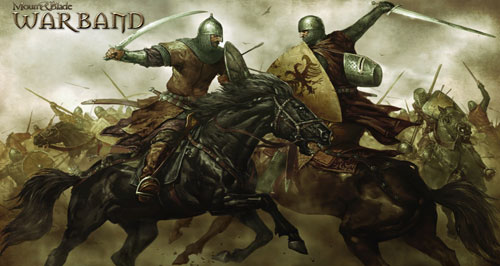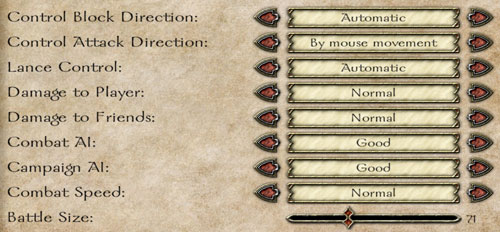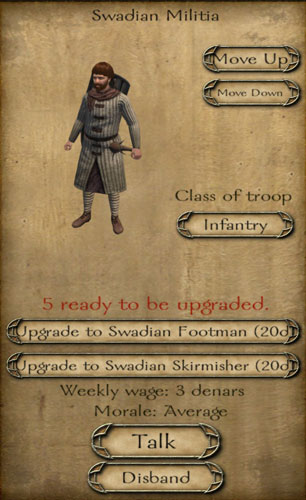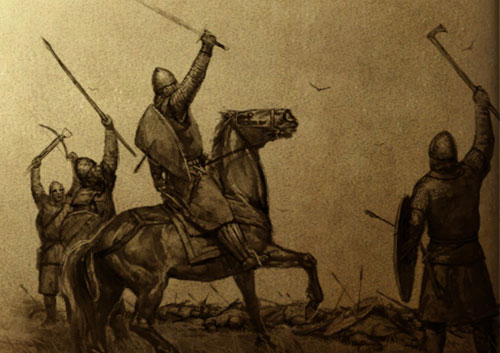
There was nothing quite like Sid Meier’s Pirates! when it was released in 1987. It was a true sandbox in that it was not only nonlinear and open but more importantly, there were multiple roles that were viable within its game space. The player could choose to be a pirate or a pirate hunter, a trader or a plunderer, loyal to a flag or self-serving, motivated by profit or familial obligations. There were numerous choices to be made throughout the course of a campaign, and those choices had enough payoffs, tradeoffs and drawbacks to require deliberation before making a decision. All of that meant each Pirates! playthrough could be a unique adventure.
While Mount&Blade and its sequel, Mount&Blade: Warband, are set in the fictitious Calradia rather than the Caribbean, set on land rather than seas, Turkish developers Talesworlds has done a great job of capturing the Pirates! spirit without slavishly reproducing Sid Meier’s design.
The biggest difference between Mount&Blade and its inspiration is the way combat is handled. Sid Meier didn’t want the Pirates! action sequences to distract from the main flow of the game so combat was simplified and abstracted. The player could command of a fleet of ships in Pirates! but sea battles were resolved through one-on-one battles. Similarly, boarding an enemy ship might see hundreds of sailors do battle yet the outcome hinged on a duel between the individual captains. As a result, battles in Pirates! were quickly concluded, letting the player get back to making interesting choices to craft unique storylines.
Skill to kill
In marked contrast to Pirates!’s minigame approach, Mount&Blade’s battles are complex affairs which require both twitch-based skill and tactical acumen.
(There is also an RPG layer that affects everything in the game including the combat but that’s best discussed separately.)
Mastering the melee, ranged and mounted combat mechanics is not a trivial task even at lower levels of difficulty. Patience is required to wait for openings, quick reflexes and timing are vital for both strikes and shield blocks, and hitting a distant target with a ranged weapon requires genuine skill. If nothing else, Mount&Blade ought to give players greater appreciation for the horseback archer’s extraordinary ability to hit moving targets while on the gallop.
It must be pointed out the combat mechanics do not faithfully simulate medieval warfare as Taleworlds has wisely erred on the side of fun. Stamina isn’t modelled and wounds do not take a toll on ability in battle so a fully-armoured knight can cheerfully scamper about and vigorously wave a great sword around even with a sliver left on the health bar.
On the whole, however, Mount&Blade does well to convey the essence of medieval combat without burdening the player with unwieldy detail.
Tough enough
Taleworlds’ handling of challenge is particularly noteworthy. The developer has done an excellent job of allowing the game’s difficulty to be fine-tuned to suit personal taste and should be further commended for permitting those difficulty settings to be changed at any time during the lengthy campaign.
(Those might only be natural things to do at a time when the game industry is struggling to accommodate both neophytes and veterans but exasperatingly, most designers are content to rely on inflexible Easy, Normal and Hard difficulty settings.)

More interestingly, tweaking settings like combat AI, combat speed or the amount of damage sustained during battles can also dramatically alter the complexion of the game.
At lower levels of difficulty, battles in Mount&Blade almost resemble an action game. Taleworlds made a lot of concessions for those with poor twitch skills or tactical ability, effectively turning them into superheroes whose very presence on the battlefield acts a force multiplier. The player can fearlessly mow down enemies by the dozens and the player’s troops serve primarily as a post-victory cheering section. It’s certainly enjoyable but achieving victory in battles doesn’t feel like much of an accomplishment.
Think then thwack
With the difficulty increased, Mount&Blade demands a different set of skills as the game turns into a more tactical experience, one that will satisfy anyone looking for a real challenge.
The player character remains the most important unit on the battlefield but is considerably more vulnerable now. Charging around recklessly on the battlefield will only lead to frustration since three arrows shot swift and true from shoddy bows can bring down even a heavily armoured knight. Although the player character can never die in battle, troops suffer a precipitous drop in morale and consequently lose effectiveness whenever their leader is knocked out. It is therefore imperative to stay in the fight to avoid a Pyrrhic victory or an outright defeat.
As the player can no longer count on winning battles almost single-handedly, strategic planning and battlefield tactics take greater significance. The player’s army must be carefully managed: supplies must be procured, losses must be promptly replaced, morale kept high to avoid desertions and troop quality improved.
Furthermore, critical decisions about army composition must be made based on the needs of the current campaign. Should the player spend money on expensive mercenaries or spend time training volunteers? Should raw recruits be trained as cavalrymen, infantry or archers?

Raising elite troops will be time-consuming and costly but they can turn the tide of battle if used correctly. Swadian Knights can be devastating on the charge, Nord Huscarls excel at infantry assaults, Khergit Horse Archers make fantastic skirmishers and Rhodok Sharpshooters will be highly useful when defending a castle.
The army’s speed must also be considered. Among other things, this depends on size (large armies tend to be sluggish), composition (a cavalry-heavy army will move briskly) and morale (disheartened troops will drag their feet). Slow armies will find it difficult to force a decisive battle against a reluctant enemy while a fast-moving army can not only pick its fights but where to fight. Choosing the right terrain is vital if the army is to make the most of its strengths. For example, an army heavily reliant on cavalry should pick flat ground conducive to charges for battlegrounds.
In battle, the game’s basic troop orders are sufficient for rudimentary tactics. Cavalry can be commanded to outflank dangerous pikemen, archers can be placed on elevated positions and troops can even be ordered to use blunt weapons in order to capture as many prisoners as possible. No one is going to ever mistake Mount&Blade for a full-on medieval wargame but again, it does provide enough flavour to be satisfying.

Mount&Blade’s strong emphasis on combat is unsurprising since Taleworlds started with sword-fighting and mounted combat mechanics before crafting a game around them. That emphasis paid off because no other game does medieval combat as well.
(The Total War series comes close but in those strategy games the player is a director of the action; in Mount&Blade, the player is the actor.)
Indeed, there are few game experiences as thrilling as going on a cavalry charge in Mount&Blade — lance at the ready, horse swiftly closing the distance to the enemy, hooves beating a thunderous beat, the metallic K’SHINGKT as steel pierces armour and flesh.
The biggest compliment that can be paid to Mount&Blade’s combat is that it doesn’t lose its appeal even deep into the game’s lengthy campaign. Moreover, the ability to change the difficulty and complexion means the combat can remain engaging even after a few dozen hours of play. The game has its problems but the complex combat mechanics are not among them.
